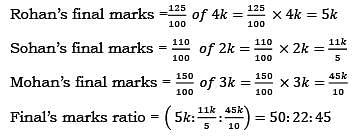Manipur PSC Prelims Paper 2 Mock Test - 5 - Manipur CSCCE MCQ
30 Questions MCQ Test - Manipur PSC Prelims Paper 2 Mock Test - 5
Study the following information carefully to answer the questions.
Amul, Byomkesh, Chaman, Diksha, Emily, Fahim and Gauri are seated in a straight line facing north but not necessarily in the same order.
- Only three people sit between Fahim and Byomkesh.
- Neither Fahim nor Byomkesh sits at the extreme ends of the line.
- Only two people sit between Byomkesh and Emily.
- Diksha is not an immediate neighbour of either Byomkesh or Fahim.
- Diksha sits third to the left of Gauri.
- Gauri is not an immediate neighbour of Byomkesh.
- Diksha is not an immediate neighbour of Amul.
Who are immediate neighbours of Chaman?
Amul, Byomkesh, Chaman, Diksha, Emily, Fahim and Gauri are seated in a straight line facing north but not necessarily in the same order.
Study the following information carefully to answer the questions.
Amul, Byomkesh, Chaman, Diksha, Emily, Fahim and Gauri are seated in a straight line facing north but not necessarily in the same order.
- Only three people sit between Fahim and Byomkesh.
- Neither Fahim nor Byomkesh sits at the extreme ends of the line.
- Only two people sit between Byomkesh and Emily.
- Diksha is not an immediate neighbour of either Byomkesh or Fahim.
- Diksha sits third to the left of Gauri.
- Gauri is not an immediate neighbour of Byomkesh.
- Diksha is not an immediate neighbour of Amul.
At what position Chaman is sitting from the right?
Amul, Byomkesh, Chaman, Diksha, Emily, Fahim and Gauri are seated in a straight line facing north but not necessarily in the same order.
| 1 Crore+ students have signed up on EduRev. Have you? Download the App |
Study the following information carefully to answer the questions.
Amul, Byomkesh, Chaman, Diksha, Emily, Fahim and Gauri are seated in a straight line facing north but not necessarily in the same order.
- Only three people sit between Fahim and Byomkesh.
- Neither Fahim nor Byomkesh sits at the extreme ends of the line.
- Only two people sit between Byomkesh and Emily.
- Diksha is not an immediate neighbour of either Byomkesh or Fahim.
- Diksha sits third to the left of Gauri.
- Gauri is not an immediate neighbour of Byomkesh.
- Diksha is not an immediate neighbour of Amul.
Who is sitting between Fahim and Gauri?
Amul, Byomkesh, Chaman, Diksha, Emily, Fahim and Gauri are seated in a straight line facing north but not necessarily in the same order.
Study the following information carefully to answer the questions.
Amul, Byomkesh, Chaman, Diksha, Emily, Fahim and Gauri are seated in a straight line facing north but not necessarily in the same order.
- Only three people sit between Fahim and Byomkesh.
- Neither Fahim nor Byomkesh sits at the extreme ends of the line.
- Only two people sit between Byomkesh and Emily.
- Diksha is not an immediate neighbour of either Byomkesh or Fahim.
- Diksha sits third to the left of Gauri.
- Gauri is not an immediate neighbour of Byomkesh.
- Diksha is not an immediate neighbour of Amul.
Who is sitting right to Emily?
In 10 years, A will be thrice as old as B was 5 years ago. If A is now 9 years older than B, the present age of B is:
At 5'O clock, clock ticks 5 times. The time between first and last tick was 36 sec. How much time it takes at 11'O clock?
Statements:
A. All the tiger are leopard.
B. No leopard is an elephant.
Conclusions:
- Some tigers are leopard.
- No leopard is a elephant.
A and B enter into a partnership and A invests
Rs. 15,000 in the partnership. At the end of 3 months, he withdraws Rs.5000. At the end of another 5 months, he withdraws another Rs.5000. If B receives Rs. 12,000 as his share of the total profit of Rs. 23,500 for the year, how much did B invest in the company?
Directions: These questions are based on the following pie-charts.
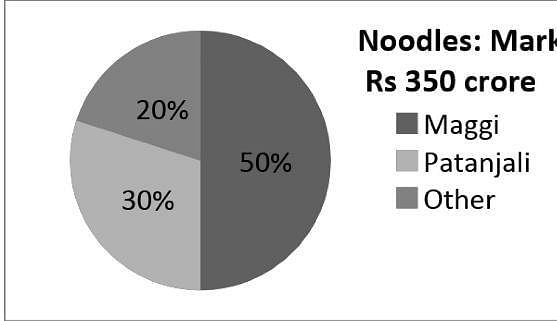
Cheese: Market size 120 crore
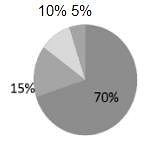
- Amul
- Vadilal
- Mother Dairy
- Other
Q. If Maggi produces Superior and Ordinary types of its products - there ratio is 2 : 3 respectively, find the total market share (in Rupees crore) of the Ordinary type of products of Maggi.
Directions: These questions are based on the following pie-charts.
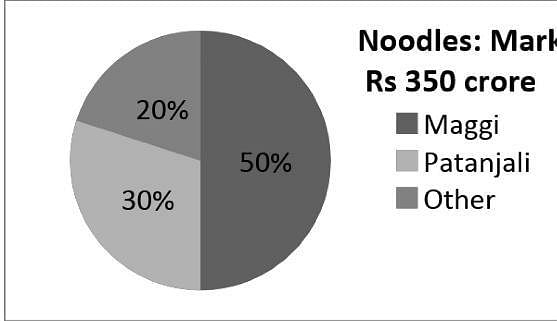
Cheese: Market size 120 crore

- Amul
- Vadilal
- Mother Dairy
- Other
Q. The elders in Kanpur recalled that a couple of decades ago when the population of the town was just 30000 (present population = 55000), they used to spend Rs 125 per capita for these items as well as bread. At that time, the total market share of bread must have been lakh rupees. Assume per capita expenses growth at 1% p.a.
Directions: These questions are based on the following pie-charts.
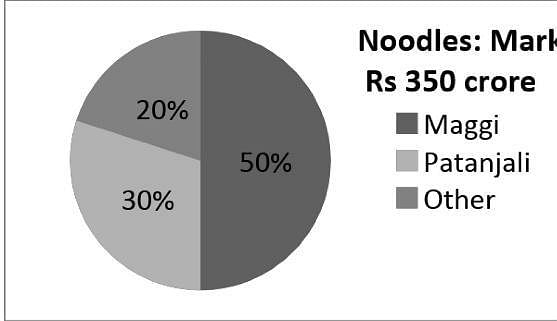
Cheese: Market size 120 crore
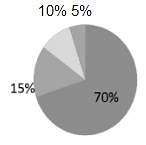
- Amul
- Vadilal
- Mother Dairy
- Other
Q. If Kisan diversified into the Noodles market, capturing 15% of the market held by Maggi, what would be the share of Kisan in the entire food market given (Rs crores)?
Directions: These questions are based on the following pie-charts.

Cheese: Market size 120 crore

- Amul
- Vadilal
- Mother Dairy
- Other
Q. If Maggi produces Superior and Ordinary types of its products - noodles and ketchup - in the ratio of 3 : 2 and 7 : 3 respectively, find the total market share (in Rupees crore) of the Ordinary type of products of Maggi.
4 equidistant vertical lines are drawn on board 4 equidistant horizontal lines are also drawn on the board cutting the 4 vertical lines, and the distance between any two consecutive horizontal lines is equal to that between any two consecutive vertical lines. What is the maximum number of squares thus formed?
In quarterly exam marks of Rohan, Sohan and Mohan are in ratio 4:2: 3. If in final exam there is increment of 25%, 10% and 50% respectively in their quarterly marks then what will be the new ratio of their final marks?
Great comic art is never otherworldly, it does not seek to mystify us, and it does not deny ambiguity by branding as evil whatever differs from good. Great comic artists assume that truth may bear all lights, and thus they seek to accentuate contradictions in social action, not gloss over or transcend them by appeals to extra social symbols of divine ends, cosmic purpose, or laws of nature. The moment of transcendence in great comic art is a social moment, born out of the conviction that we are human, even though we try to be gods. The comic community to which artists address themselves is a community of reasoning, loving, joyful, compassionate beings, who are willing to assume the human risks of acting rationally. Without invoking gods or demons, great comic art arouses courage in reason, courage which grows out of trust in what human beings can do as humans.
Q. It can be inferred from the passage that the author admires great comic artists primarily for their
Growth through acquisitions and alliances has become a critical part of creating value for pharma and biotech manufacturers and their shareholders. However, companies and their investors may risk value destruction if they acquire rights to a drug that suddenly poses unanticipated safety risks for patients. Similarly, safety related compliance violations committed by an acquired company could significantly impair the ultimate value of the transaction and the reputation of the acquirer. The pace of deal making between pharma and biotech companies continued to accelerate in 2006, increasing 17% to about $ 18 billion. Pharma companies were typically the buyers, and the premiums they paid increased substantially as competition intensified, to secure access to novel drugs and biologics. The stakes increase everyday as competition pushes up prices and drives deal making to earlier development stages with greater uncertainty and less time to complete thorough due diligence—
Q. Which of the following inference(s) is/are definitely true?
In the eighteenth century, Japan’s feudal overlords, from the shogun to the humblest samurai, found themselves under financial stress. In part, this stress can be attributed to the overlords’ failure to adjust to a rapidly expanding economy, but the stress was also due to factors beyond the overlords’ control. Concentration of the samurai in castle-towns had acted as a stimulus to trade. Commercial efficiency, in turn, had put temptations in the way of buyers. Since most samurai had been reduced to idleness by years of peace, encouraged to engage in scholarship and martial exercises or to perform administrative tasks that took little time, it is not surprising that their tastes and habits grew expensive. Overlord’s income, despite the increase in rice production among their tenant farmers, failed to keep pace with their expenses. Although shortfalls in overlord’s income resulted almost as much from laxity among their tax collectors as from their higher standards of living, a misfortune like a fire or flood, bringing an increase in expenses or a drop in revenue, could put a domain in debt to the city rice-brokers who handled its finances. Once in debt, neither the individual samurai nor the shogun himself found it easy to recover. It was difficult for individual samurai overlords to increase their income because the amount of rice that farmers could be made to pay in taxes was not unlimited, and since the income of Japan’s central government consisted in part of taxes collected by the shogun from his huge domain, the government too was constrained.
According to the passage, the major reason for the financial problems experienced by Japan’s feudal overlords in the eighteenth century was that
In the eighteenth century, Japan’s feudal overlords, from the shogun to the humblest samurai, found themselves under financial stress. In part, this stress can be attributed to the overlords’ failure to adjust to a rapidly expanding economy, but the stress was also due to factors beyond the overlords’ control. Concentration of the samurai in castle-towns had acted as a stimulus to trade. Commercial efficiency, in turn, had put temptations in the way of buyers. Since most samurai had been reduced to idleness by years of peace, encouraged to engage in scholarship and martial exercises or to perform administrative tasks that took little time, it is not surprising that their tastes and habits grew expensive. Overlord’s income, despite the increase in rice production among their tenant farmers, failed to keep pace with their expenses. Although shortfalls in overlord’s income resulted almost as much from laxity among their tax collectors as from their higher standards of living, a misfortune like a fire or flood, bringing an increase in expenses or a drop in revenue, could put a domain in debt to the city rice-brokers who handled its finances. Once in debt, neither the individual samurai nor the shogun himself found it easy to recover. It was difficult for individual samurai overlords to increase their income because the amount of rice that farmers could be made to pay in taxes was not unlimited, and since the income of Japan’s central government consisted in part of taxes collected by the shogun from his huge domain, the government too was constrained.
The passage implies that individual samurai did not find it easy to recover from debt for which of the following reasons?
By religion, I do not mean formal religion, or customary religion, but the religion which underlies all religions, which bring us face to face with our maker. Let me explain what I mean by religion. It is not the Hindu religion which I certainly prize above all other religions, but the religion which transcends Hinduism, which changes one very nature, which binds one indissolubly to the truth within and which ever purifies. It is the permanent element in human nature which counts no cost too great in order to find full expression and which leaves the soul utterly restless until it has found itself, known its maker and appreciated the true correspondence between the Maker and itself. I have not seen him, neither have I known Him. I have made the world’s faith in God my own, and as my faith is ineffaceable, I regard that faith as amounting to experience. However, as it may be said that to describe faith as experience is to tamper with truth, it may perhaps be more correct to say that I have no word for characterizing my belief in God. There is an independent mysterious Power that pervades everything. I feel it, though I do not see it. It is the unseen power which makes itself and yet defies all proofs because it is so unlike all that I perceive through my senses. It transcends the senses. But it is possible to reason out the existence of God to a limited extent.
Which of the following elements would be present in the author’s concept of religion?
1. It is a reflection of the truth within.
2. It may or may not be present in human nature.
3. It transcends the customary and formal religion.
4. It seeks the maker.
5. Its characteristics undergo change with time and place.
6. It transcends Hinduism.
Which of the following can be said to be the author’s view about the existence of God?
Statement:
A. There is growth in terrorism in Pakistan.
B. Pakistan faced growing international opposition for its decision of not banning terrorist’s political parties.
Conclusion:
1. The citizens of Pakistan favoured the decision.
2. Some powerful terrorist organisations have a number of seats in Pakistani government.
Statement:
A. Daily soap for women is generally senseless.
B. Women love to watch daily soap.
Conclusions:
1. Women are senseless.
2. All daily soaps are senseless.
A group of men could do a piece of work in 18 days. However, 6 men left the group before the work began and the remaining men in the group completed the work in 20days. What was the original size of the group?
A water tank is 2/5 th full. Pipe A can fill a tank in 10 minutes and pipe B can empty in 6 minutes. If both the pipes are open, how long will it take to empty or fill the tank completely?
Directions for the following 3 (three) questions:
Following table shows list of features available in mobile phones. Study the table and answer the questions given below.
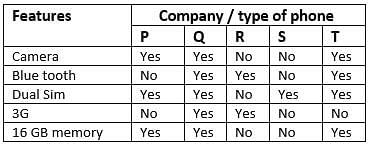
Q. Which features are present in maximum and minimum types of phones respectively?
Following table shows list of features available in mobile phones. Study the table and answer the questions given below.
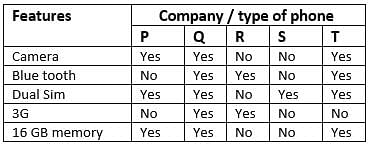
Q. Price of phone is exactly equal to sum of prices of each feature. A phone with all features like Q can be assembled by how many ways?
Following table shows list of features available in mobile phones. Study the table and answer the questions given below.

Q. If Ram is looking for phone with camera and dual sim but no 3G. How many options he has?
Directions for the following 4 (four) items:
Following graph shown milk production, in thousand liters from 2005 to 2010.
Q. The increase in production in 2006-07 is what percentage of increase in 2005-06?
Following graph shown milk production, in thousand liters from 2005 to 2010.
Q. Which year production is 50% of the sum of production of 2008 and 2010?
Following graph shown milk production, in thousand liters from 2005 to 2010.
Q. Ratio of Sum of production during 'odd' years to that of the 'even' years?





 Now, we can answer these questions easily, with the help of the above arrangement.
Now, we can answer these questions easily, with the help of the above arrangement.
